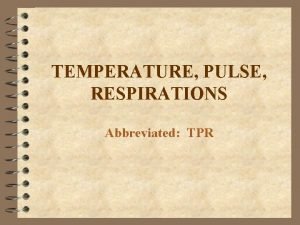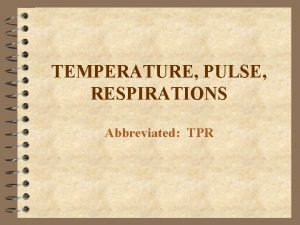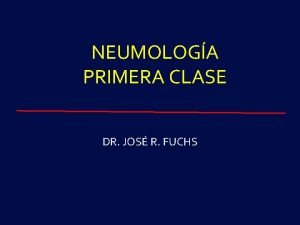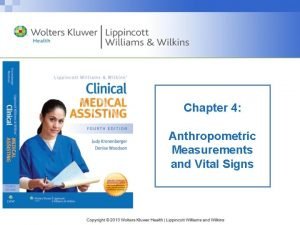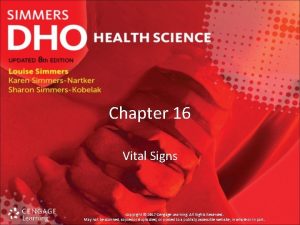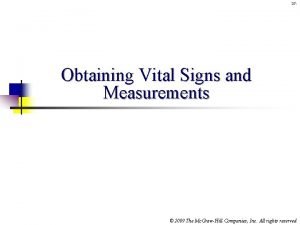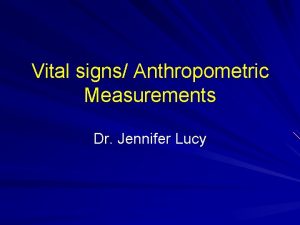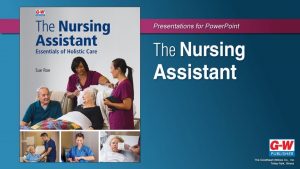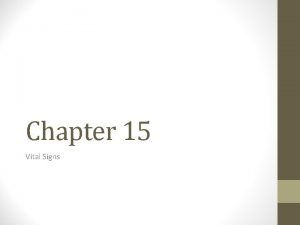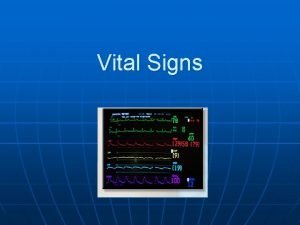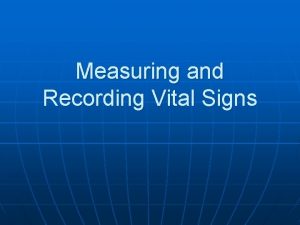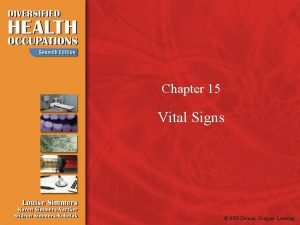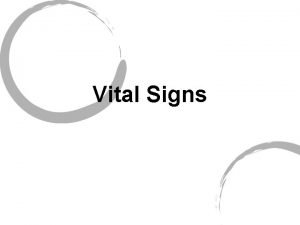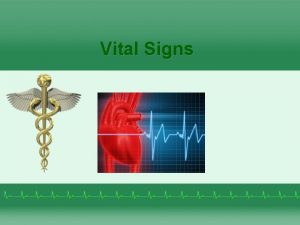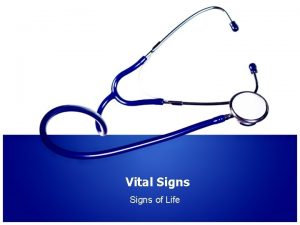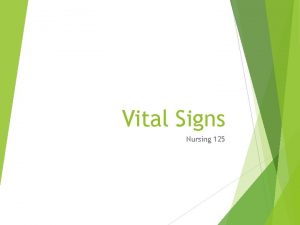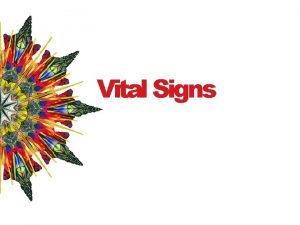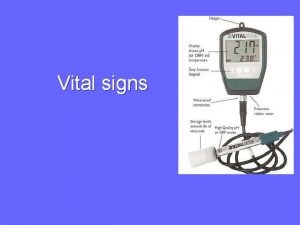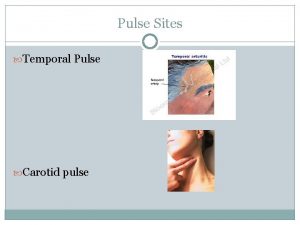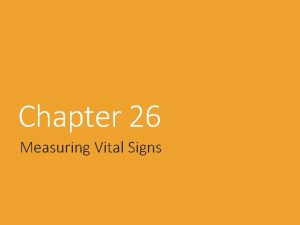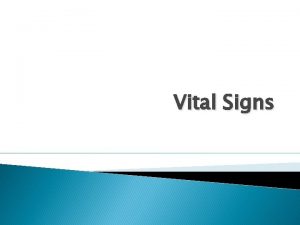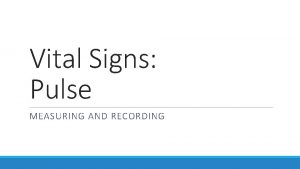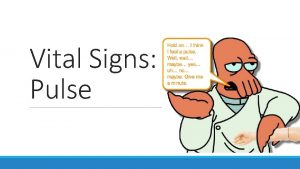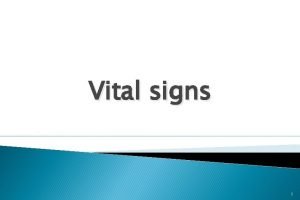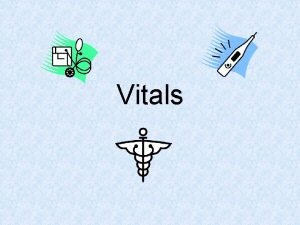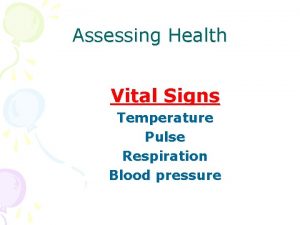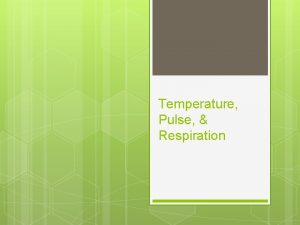Vital Signs Overview vital signs Respiration Pulse and



























- Slides: 27

Vital Signs

Overview • • • vital signs Respiration Pulse and blood pressure Pulse Sites Skin signs Pupils

Introduction • Vital signs provide information about physical condition and health • Monitoring vital signs allows identification of acute changes • Acute—sudden • Chronic—long-term

Vital Signs • measurement of patient’s condition • One direct method for being able to tell what is going on inside of someone's cardiovascular and respiratory system

Figure 12. 8 A. Constricted pupils B. Dilated pupils C. Unequal pupils (anisocoria)

Pupils – Light: pupil constricts – Light removal: pupil dilates – PERRL: pupils equal, round, and reactive to light – Brain and eye injuries alter normal reaction

Skin Signs • Skin color – Sign of respiratory and circulatory system functioning • Skin temperature and moisture – Feel forehead or abdomen • Capillary refill – Time for blood to return after skin is compressed (usually done on the fingernail)

Figure 12. 4 Note the pallor, a sign of shock

Pulse • Measures rate, strength, regularity of blood volume pumped by the heart

Pulse (cont’d. ) • Pulse rate – Health Care workers must know normal heart rate ranges • Pulse quality – Strong pulse: full and strong – Bounding pulse: abnormally strong – Weak pulse: difficult to find and feel – Thready pulse: weak and rapid (usually seen dehydrated or shock)

Normal Pulse • *Adult 60 -100 • Child 80 -120 • Newborn 120 -160

Pulse Terms • Tachycardia- is a faster than normal heart rate at rest. Above 100 • Bradycardia- is a slower than normal heart rate. Below 60

Pulse Sites

Respiration **** • Respiratory quality – Observe: • • Depth Regularity Unusual noise Effort

Respiration • Respiratory rate – health care workers must know normal values! – Count number of breaths (inspiration and exhalation) – 30 seconds X 2=

Normal Respirations • 12 -20 per min

Respiration • Classic signs of labored breathing: -Gurgling – Wheezing – Grunting

Respiration – Patients who have difficulty breathing may appear uncomfortable – Patients may show signs of increased effort or difficulty (Labored)

Pulse Oximetry • Quantifies effectiveness of breathing • Infrared light estimates percent of blood oxygenated in capillaries – 90% to 100%: normal – Below 90%: inadequate – AKA- O 2 sat (oxygen saturation in the blood)

Blood Pressure • Measure of pressure of blood against artery walls for each contraction • Sphygmomanometer: measures blood pressure • Systolic pressure: contraction • Diastolic pressure: relaxation

Adult Normal Blood Pressure Ranges • Systolic: 90 -120 (top #) First sound heard ___________ • Diastolic: 60 -80 (Bottom #) Last sound heard


Where does it go?


Cyanosis • Blueish grey coloring of the skin • Caused by lack of oxygen or perfusion

Arms—does it matter? • Which one to use?

Conclusion • Health care workers must gather baseline information on every patient! • Familiarity with normal values is important! – Helps identify abnormal vital signs • Ongoing assessment helps Health care workers adjust treatments and improve response and condition
 Temperature
Temperature Abbreviation for temperature pulse and respiration
Abbreviation for temperature pulse and respiration All traffic signs and meanings
All traffic signs and meanings Tpr temperature pulse respiration
Tpr temperature pulse respiration External vs internal respiration
External vs internal respiration The nose serves all the following functions except
The nose serves all the following functions except Overview of cellular respiration
Overview of cellular respiration Overview of respiration
Overview of respiration Overview of cellular respiration
Overview of cellular respiration Overview of cellular respiration
Overview of cellular respiration Apical pulse location
Apical pulse location Volúmenes pulmonares
Volúmenes pulmonares Test unit 14 vital signs
Test unit 14 vital signs Temperature is an anthropometric measurement
Temperature is an anthropometric measurement Chapter 36 body measurements and vital signs
Chapter 36 body measurements and vital signs 16:7 measuring and recording blood pressure
16:7 measuring and recording blood pressure Normal range for vital signs
Normal range for vital signs Vital signs and anthropometric measurements:
Vital signs and anthropometric measurements: Vital signs height and weight
Vital signs height and weight Where is apical pulse taken
Where is apical pulse taken Measuring and recording temperature
Measuring and recording temperature Measuring and recording respirations
Measuring and recording respirations Why are vital signs recorded on a graphic record
Why are vital signs recorded on a graphic record Vital sign
Vital sign Normal level of vital signs
Normal level of vital signs What are the 7 vital signs
What are the 7 vital signs Respiration rate
Respiration rate 8 vital signs
8 vital signs

